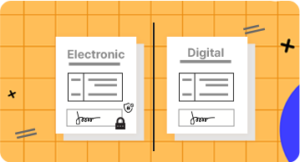Digital Signature – A Complete Guide
A signature holds the power to validate a document’s integrity and authenticity. A digital signature’s work is kind of similar but it uses a mathematical technique to validate the integrity of a message or a digital document.
This electronic signature provides the source, identity, and even the status of electronic documents, digital messages. This type of encryption is used by businesses all over the globe due to its tight and efficient encryption.
What is a digital signature?
Ever heard of electronic fingerprints?
Digital signatures are kind of similar to electronic fingerprints and it comes in the form of a coded message.
It connects the signer with a specified signed document, in a very secure way. It also used Public Key Infrastructure or PKI for securing the documents. It is the highest level of security they can provide and this format is also accepted universally.
How digital signature works?
Well, similar to written signatures, digital signatures are unique for each individual signer.
- Several organizations provide solutions for digital signatures and they use a very specific procedure for solving them. This procedure is popularly known as PKI.
- PKI is also known as Public Key Infrastructure and it uses a mathematics-based algorithm. The algorithm is designed to produce two unique numbers. These numbers are also defined as keys. One of these 2 numbers is called a public key and the other one is known as a private key.
- So, when a signer is signing a document digitally, a signature is being created with the private key of the signer. This key is encrypted and known only to the signer.
- The algorithm works similarly to a cipher. It creates data similar to the signed document which is called hash. Then, encrypts that data.
- In the end, that encrypted data is the digital signature.
- When a document is signed, it is also marked with time. So, if the document gets altered after it was signed, the digital signature becomes invalid.
- So, protecting the integrity of the said document is also very important. This is the reason, PKI needs to create those keys and needs to store them in a secure way which requires the help of a reliable Certificate Authority or CA.
Benefits of digital signature
There are several benefits to the digital signature but it is mostly known for its high-level security. When it gets implanted on a document, it is ensured that the said document will not be altered in any manner. Its use is completely legitimate and comes with the following benefits.
Personal Identification Numbers or PINs, Passwords and Codes
The digital signature is used for authentication. It is used for verification purposes. Most commonly used with emails, usernames, and passwords.
Asymmetric Cryptography
It also uses the public-key algorithm. This algorithm comes with encryption and authentication for both public and private keys.
CRC or Cyclic Redundancy Check
CRC is a feature that is designed for the verification process of digital signatures. This feature is used to detect any alteration to the raw data.
CA or Certificate Authority Validation
CAs are the 3rd parties that are involved in the process. They accept, verify, issue, and even maintain the digital certificates. CAs also prevent the creation of fake digital certificates.
These are the main benefits of using a digital signature. But it is also associated with other benefits like timestamping, Universal acceptance, cost-saving, time-saving, positive environmental impact, and traceability.
Are digital signatures safe?
“Can my digital signature be forged, misused, or copied?”
The truth is, anything can be forged or altered with proper resources and expertise. But if we compare a digital signature to a conventional signature; the electronic signature will be proven valiant and more secure with any question.
An electronic signature comes with layers of security and authentication process that are very difficult to break. A digital signature comes with 2 keys, designed to protect the integrity of the document and the signer’s identity at all costs.
How to create a digital signature?
Digital signatures are easy to create.
- In order to create a digital signature, an email program is used to provide a one-way hash of the electronic data to be signed.
- So, what is a hash? Hash is a continuous string of letters and numbers that gets created by the algorithm. Then, the private key of the signer is used to encrypt the hash. That encrypted hash compiled with other information is the digital signature.
- Why not encrypt the entire message instead of hash? Well, the hash function is capable of converting any arbitrary input into a fixed length value. Which is very short compared to the entire message. This saves time.
- For the hashed data the value of hash is exclusive. So, if there are any changes in the data, even if a single thing gets changed in the document, the value will be different. This particular property helps other use the public key of the signer to decrypt the document while the integrity of the document stays untouched.
- After decryption, if the hash matches with a second computed hash with the same data, this means that there wasn’t any manipulation in the data. Now, if the hashes do not match, it is time to worry. Either data was tampered with and it has compromised or the signature was initially created with a private key that didn’t match the public key of the signer. Authentication will be an issue here.
Lastly, a digital signature can be used for all kinds of messages. The encryption doesn’t matter here, but this helps to ensure or confirm the identity of the sender and the integrity of the message by the receiver. Even if the signer denies sending that specific message, the evidence is just there with the unique signature of the signer.
Many times, the difference between a digital certificate and a digital signature is confusing to most people. They are completely different from each other. The digital certificate is actually an electronic document and it contains the digital signature which must have to be issued by a CA. It helps to verify the identity of the signer by using a very specific identification process.
In today’s environment, digital signatures play an important role in making businesses efficient and secure. At MSB Docs, we strive to help companies across industries with requests to sign any type of documents from anywhere on the globe while maintaining the legal sanctity of the transaction in the most efficient way possible.
FAQ regarding Digital Signature.
Are digital signatures legal to use?
Yes, digital signatures are legal to use. In the ESIGN Act, electronic signatures are defined as “an electronic sound, symbol, or a process attached to or logically associated with a contract or other record and executed or adopted by a person with the intent to sign the record”. This means electronic signatures are legally recognized.
What is PKI?
PKI, also known as Public Key Infrastructure is a series of requirements that allows the creation of digital signatures. Each digital signature transaction gets processed using PKI. This involves using 2 keys. A private key, known only to the signer and a public key.
What is a digital certificate?
During the process, a Certificate Authority or CA issues an electronic document. This document is called a digital certificate. This document contains the public key for the specified digital signature and associates the signer’s identity with the key.
Are digital signatures secured?
Yes, digital signatures are secure and falsification is really difficult. It is based on asymmetric cryptography which uses a private key that is known only to the signer. And a public key that is available to all.
Why companies adopt digital signature?
There are several benefits of digital signatures. It makes the workplace more efficient and secure. This is the reason the companies are keen on adapting digital signatures.


